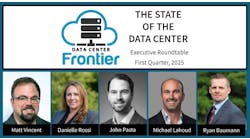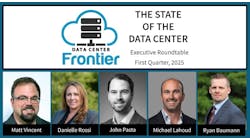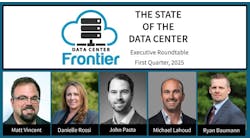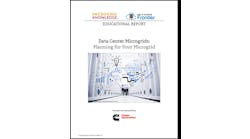Executive Roundtable: Innovation Paths for Energy-Efficient AI Data Centers
For the fourth and final installment of our Executive Roundtable for the Third Quarter of 2024, we asked our four seasoned data center industry leaders about the roadmap for innovation in AI data center infrastructure optimization for ongoing energy efficiency gains and maximum clean energy utilization.
To that end, in a recent DCF 'Voices of the Industry' guest article, Andrew Batson, Head of U.S. Data Center Research for JLL, addresses the viability of today’s most commonly discussed bridge power solutions in the data center industry. Batson notes how, with local grids stretched to the limit, data centers need a plan for reliable supplemental power.
Batson's article provides a handy rundown of the various power sources that can help “top off” the grid during peak capacity times, with the pros and cons of each, including natural gas, battery storage, fuel cells, solar and wind power, nuclear small modular reactors (SMRs) and diesel generators.
Ways of factoring power into the correct data center locational choice are also discussed.
Our panel of data center industry leaders for DCF's Executive Roundtable for the Third Quarter of 2024 includes:
Danielle Rossi, Global Director – Mission Critical Cooling, Trane
Sean Farney, VP of Data Center Strategy for the Americas, JLL
Harry Handlin, U.S. Data Center Segment Leader, ABB
Josh Claman, CEO, Accelsius
Now onto the fourth question of the series for our Executive Roundtable for the Third Quarter of 2024.
Data Center Frontier: What's the best path forward for innovation in data center infrastructure optimization, in terms of engineering for ongoing energy efficiency gains and maximum clean energy utilization in the face of AI's exponential power requirements?
Danielle Rossi, Trane: Going forward, data center planning will need to be done more holistically, thinking outside the site.
Until this point, standard considerations for site choice included power availability, cost of power, ambient temperature, ease of access, etc.
Long term planning will also need to require considering possible heat reuse on site or nearby and even site power creation.
Several countries have legislation in the EU requiring heat reuse for new data center projects, and more countries are looking to do the same.
There are many ways to implement heat reuse, but most designers stop after ruling out a district heat option.
Heat recovery can be done by many chillers and heat rejection systems and is an easy addition to a design. The recovered heat can be used for indoor agriculture, fish farming, industrial laundromats, adjacent office space, community pools, etc.
Potential heat reuse options should be considered before site selection to best benefit efficiency.
There is no bigger topic in the data center space than power shortages. There are moves toward secondary and tertiary markets, as well as discussions about pairing with or utilizing existing nuclear facilities to gain access to power.
Additionally, alternate conversations about dedicated sustainable power, such as wind, water or solar, have been increasing.
The use of any of these, in addition to product-specific energy saving methods such as controls and thermal or energy storage, will optimize the efficiency of the site in the best way possible.
Sean Farney, JLL: The industry was already challenged by sustainability goals and regulatory reporting requirements when market interest in AI productization started surging.
This black swan AI event took even the best and most deep-pocketed planners by surprise, but it also created opportunity.
The immediate imperative to deliver change was the impetus we needed to revamp the way we'd been doing things for many years.
Cooling is a prime example. Liquid cooling has been around since at least the days of mainframes, but operators feared the technology for far too long.
AI's massive power/heat density and dramatic market growth forced innovation that ushered in the new cooling tech we needed to minimize environmental footprints.
Liquid cooling can reduce carbon impact by around 40% compared to computer room air conditioners and handlers (CRACs and CRAHs).
I believe we will see a similar paradigm shift in the use of natural gas power plants and behind-the-meter power systems, including small modular nuclear reactors (SMRs), to provide predictable supplies of stable, lower carbon energy.
Harry Handlin, ABB: Data center PUE will increase for AI.
The two issues with higher rack densities are how do you get power in and how do you get the heat out.
We anticipate innovations in liquid cooling, which will lead to greater efficiencies.
We also expect to see on-site power generation, leading to microgrids with multiple sources of supply.
Another design shift we anticipate is the integration of medium voltage (MV) systems to support the growing scale of the data center's increase in block sizes.
Josh Claman, Accelsius: As an industry, we’re going to need to plan for rack densities of 200 to 300 kW, which means we’ll need to prepare for power conditioning that can deliver that level of power to individual racks.
Of course, that uptick in rack density means we’ll also need to think about water—mainly shifting from evaporative towers to a closed loop. This also probably necessitates a shift in the development of data centers away from hot, arid locations with scarce water and rapidly emptying aquifers towards more northern locations.
Finally, we see a positive change in the perspective of colocation providers.
Traditionally, these companies have been relatively glib about efficiency. They passed the cost of the inefficiency onto their clients.
However, we now sense a change – not only are colos focusing more on efficiency, but we also see them wanting to take more of a thought leadership role in power and cooling architectures.
It’s time to think beyond our industry.
We continue to hear of protests labeling data centers as “energy vampires.” Data center companies can no longer justify a new build with high PUEs or even higher water consumption to existing communities.
Whether we like it or not, our industry needs to get serious about sustainability. We need to make every watt count.

Matt Vincent
A B2B technology journalist and editor with more than two decades of experience, Matt Vincent is Editor in Chief of Data Center Frontier.










